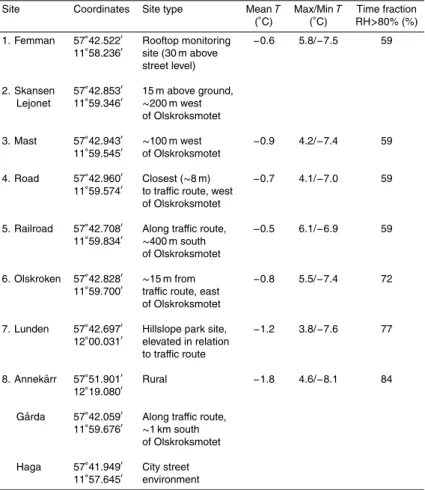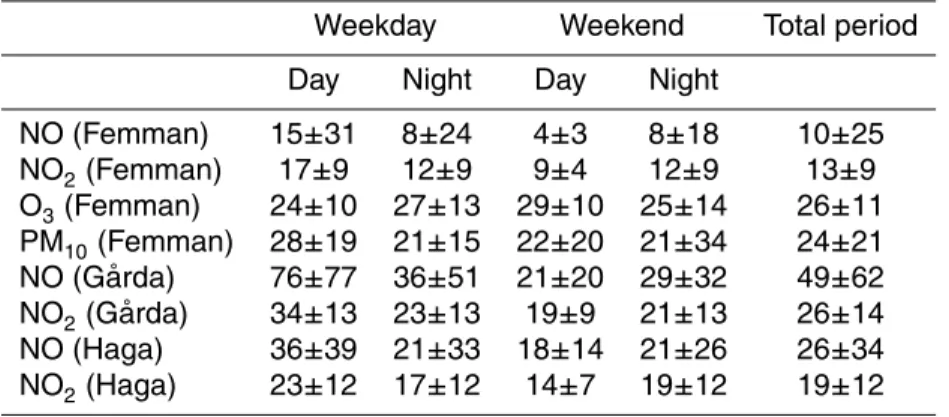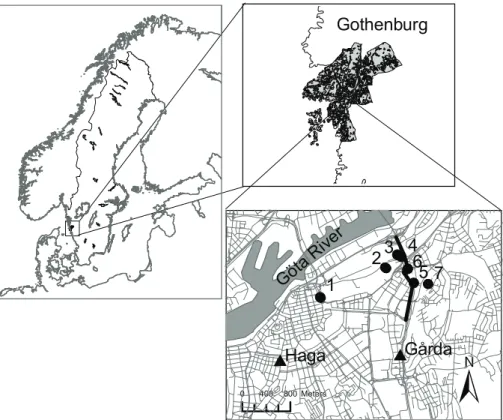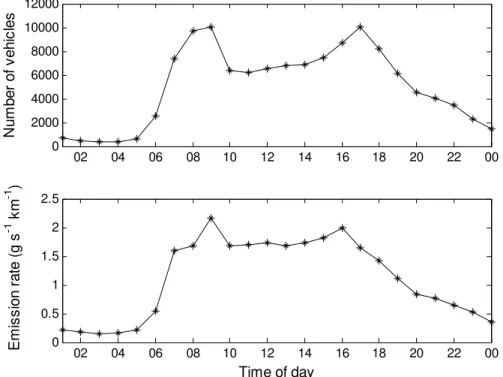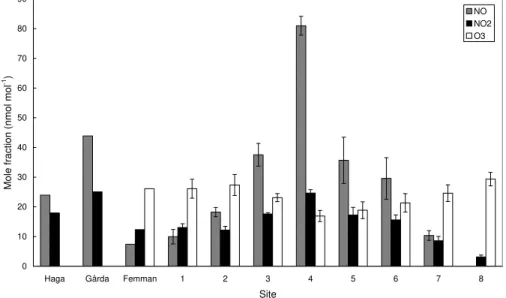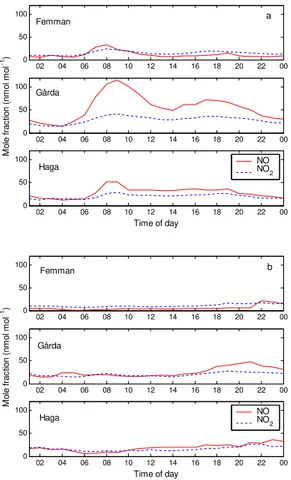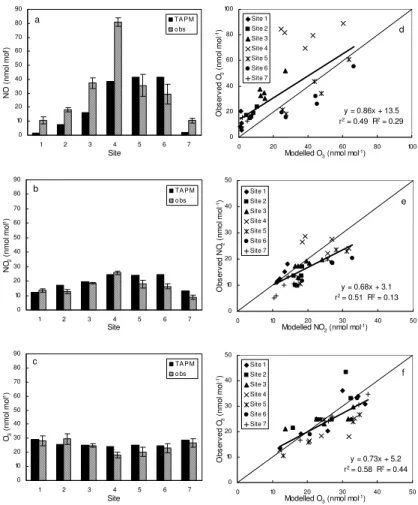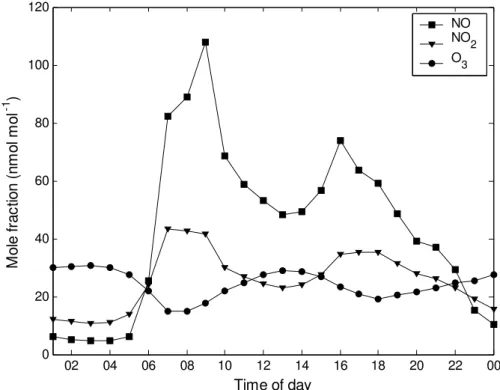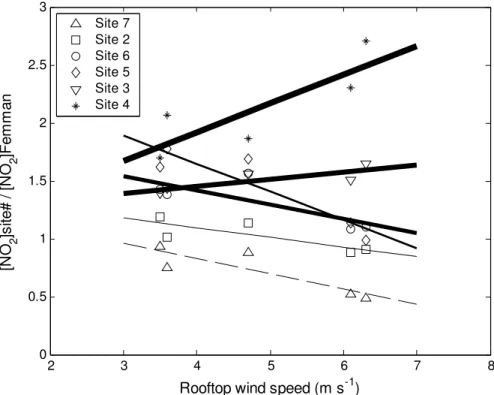ACPD
9, 2081–2111, 2009Modelled and measured NO, NO2
and O3in the urban landscape
J. Klingberg et al.
Title Page
Abstract Introduction
Conclusions References
Tables Figures
◭ ◮
◭ ◮
Back Close
Full Screen / Esc
Printer-friendly Version
Interactive Discussion
Atmos. Chem. Phys. Discuss., 9, 2081–2111, 2009 www.atmos-chem-phys-discuss.net/9/2081/2009/ © Author(s) 2009. This work is distributed under the Creative Commons Attribution 3.0 License.
Atmospheric Chemistry and Physics Discussions
This discussion paper is/has been under review for the journalAtmospheric Chemistry
and Physics (ACP). Please refer to the corresponding final paper inACPif available.
Spatial variation of modelled and
measured NO, NO
2
and O
3
concentrations
in the polluted urban landscape – relation
to meteorology during the G ¨ote-2005
campaign
J. Klingberg1, L. Tang2, D. Chen2, G. Pihl Karlsson3, E. B ¨ack4, and H. Pleijel1
1
Department of Plant and Environmental Sciences, University of Gothenburg, P.O. Box 461, 405 30 Gothenburg, Sweden
2
ACPD
9, 2081–2111, 2009Modelled and measured NO, NO2
and O3in the urban landscape
J. Klingberg et al.
Title Page
Abstract Introduction
Conclusions References
Tables Figures
◭ ◮
◭ ◮
Back Close
Full Screen / Esc
Printer-friendly Version
Interactive Discussion
3
Swedish Environmental Research Institute (IVL), P.O. Box 5302, 400 14 Gothenburg, Sweden
4
City of Gothenburg, Environmental Administration, Karl Johansgatan 23, 414 59 Gothenburg, Sweden
Received: 6 November 2008 – Accepted: 3 December 2008 – Published: 22 January 2009
Correspondence to: J. Klingberg (jenny.klingberg@dpes.gu.se)
ACPD
9, 2081–2111, 2009Modelled and measured NO, NO2
and O3in the urban landscape
J. Klingberg et al.
Title Page
Abstract Introduction
Conclusions References
Tables Figures
◭ ◮
◭ ◮
Back Close
Full Screen / Esc
Printer-friendly Version
Interactive Discussion Abstract
Knowledge about temporal and spatial variations of the O3and NOxrelationship in the urban environment are necessary to assess the exceedance of air quality standards for NO2. Both reliable measurements and validated high-resolution air quality models are important to assess the effect of traffic emission on air quality. In this study,
measure-5
ments of NO, NO2and O3concentrations were performed in Gothenburg, Sweden, dur-ing the G ¨ote-2005 campaign in February 2005. The aim was to evaluate the variation of pollutant concentrations in the urban landscape in relation to urban air quality mon-itoring stations and wind speed. A brief description of the meteorological conditions and the air pollution situation during the G ¨ote-2005 campaign was also given.
Further-10
more, the Air Pollution Model (TAPM) was used to simulate the NOx-regime close to an urban traffic route and the simulations were compared to the measurements. Im-portant conclusions were that the pollutant concentrations varied substantially in the urban landscape and the permanent monitoring stations were not fully representative for the most polluted environments. As expected, wind speed strongly influenced
mea-15
sured pollutant concentrations and gradients. Higher wind speeds dilute NO2 due to stronger dispersion; while at the same time vertical transport of O3is enhanced, which produces NO2 through oxidation of NO. The oxidation effect was predominant at the more polluted sites, while the dilution effect was more important at the less polluted sites. TAPM reproduced the temporal variability in pollutant concentrations
satisfacto-20
rily, but was not able to resolve the situation at the most polluted site, due to the local scale site-specific conditions.
1 Introduction
It is well documented that nitrogen dioxide (NO2) and ozone (O3) can adversely affect human health (Curtis et al., 2006). In the European Union Framework Directive on Air
25
ACPD
9, 2081–2111, 2009Modelled and measured NO, NO2
and O3in the urban landscape
J. Klingberg et al.
Title Page
Abstract Introduction
Conclusions References
Tables Figures
◭ ◮
◭ ◮
Back Close
Full Screen / Esc
Printer-friendly Version
Interactive Discussion
(1999/30/EC) limit values for nitrogen dioxide (NO2) concentration are defined as an hourly average of 200µg m−3(
∼105 nmol mol−1, 99.8-percentile) and an annual aver-age of 40µg m−3(
∼21 nmol mol−1), to be achieved by 1 January 2010. Measurements and modelling indicate that many urban areas will have problems to reach the air quality standard for NO2, especially close to major traffic routes (Carslaw et al., 2007; Pleijel
5
et al., 2009).
The levels of NO2and O3are closely linked by the chemical coupling of O3with NOx (NO2+NO). O3levels are generally lower at ground level in streets than at rooftops or in the surrounding countryside due to the titration of O3 by NO in car exhaust to form NO2(Fenger, 1999). Therefore reductions of NOxemissions in the cities are frequently
10
accompanied by an increase in the level of O3. A better understanding of the relation-ships between O3, NO and NO2, as well as the influence of the state of the atmosphere is necessary to evaluate the exceedances of air quality standards (Clapp and Jenkin, 2001). In addition, both for air quality forecasting and for development of control strate-gies it is important to identify the factors controlling the NO2 concentrations (Shi and
15
Harrison, 1997).
The spatial variability of air pollutants is large in urban areas (Coppalle et al., 2001; Vardoulakis et al., 2005). Therefore exposure to air pollutants is strongly dependent on location. Cost, bulk of equipment, power supply, etc. often put practical limits to the number of air quality monitoring stations in a city. In many cities air pollutants are only
20
measured at one or a few locations. It is therefore very important to assess the repre-sentativeness of these locations (Flemming et al., 2005). How far from traffic routes the local impact of traffic emissions reaches and to which amount these emissions affect the formation or destruction of ozone is not well known (Suppan and Sch ¨adler, 2004). Both measurements and validated high resolution air quality model calculations are
25
ACPD
9, 2081–2111, 2009Modelled and measured NO, NO2
and O3in the urban landscape
J. Klingberg et al.
Title Page
Abstract Introduction
Conclusions References
Tables Figures
◭ ◮
◭ ◮
Back Close
Full Screen / Esc
Printer-friendly Version
Interactive Discussion
Progresses in fine scale meteorological and air chemistry modelling over the last decades have made it possible to fairly realistically model urban air pollution dynam-ics. One such model is The Air Pollution Model (TAPM), which is a three-dimensional, nestable, prognostic meteorological and air pollution model. Previous studies have shown that TAPM performs well in coastal, inland and complex terrain, in sub-tropical to
5
mid-latitude conditions (Hurley et al., 2001, 2003, 2005). Chen et al. (2002) evaluated the meteorological performance of TAPM in Gothenburg, Sweden for a two year long meteorology only simulation. The results showed that meteorological variables from TAPM were in agreement with observations on yearly and daily time scales. A recent model intercomparison study between TAPM and MM5 (the PSU/NCAR mesoscale
10
model) carried out in Gothenburg concluded that TAPM is comparable to MM5 and has better performance in urban areas (Tang et al., 2009), in terms of surface meteoro-logical variables including temperature and wind which are important to air pollution dynamics. While TAPM’s ability to realistically reproduce local meteorological condi-tions have been demonstrated and the simulacondi-tions have been successfully used in
15
urban air pollution studies (e.g. Johansson et al., 2008), its capability in reproducing local scale variability in pollutant concentrations has been tested to a lesser extent.
The measurements and modelling in this study formed part of the G ¨ote-2005 campaign (http://www2.chem.gu.se/∼hallq/Gote eng 2005.htm), which took place in
Gothenburg, South-West Sweden, from 2 February to 2 March, 2005. The
coordi-20
nation of different research groups’ measurements created a platform for cooperation and a common database with measurement data. Through coordination of unique competences, the overall goals of the G ¨ote-2005 campaign were to (1) better describe the air pollution situation in Gothenburg, (2) increase the understanding of the fate of the air pollutants near the road, (3) provide a base for risk assessment, (4) test new
25
measurement techniques and (5) evaluate air pollution models.
The objectives of the part of the G ¨ote-2005 campaign described in the present paper were:
ACPD
9, 2081–2111, 2009Modelled and measured NO, NO2
and O3in the urban landscape
J. Klingberg et al.
Title Page
Abstract Introduction
Conclusions References
Tables Figures
◭ ◮
◭ ◮
Back Close
Full Screen / Esc
Printer-friendly Version
Interactive Discussion
the G ¨ote-2005 campaign.
– Evaluate how the NO, NO2and O3concentrations varied in the urban landscape compared to permanent monitoring stations. The hypothesis was that there is a large spatial (and temporal) variability within the city, not fully resolved by the monitoring stations.
5
– Investigate how the NO2 concentrations varied with wind speed at differently pol-luted sites. The hypothesis was that the influence of wind speed/turbulence on NO2concentrations is a balance between increased dilution and enhanced verti-cal transport of O3to oxidize NO to NO2.
– Compare the observations with results from the TAPM model. The hypothesis was
10
that the model simulations would correlate well with the corresponding observa-tions, but not necessarily be able to reproduce dynamics at sites with very high pollution levels due to local scale variations in the site-specific characteristics.
2 Material and methods
2.1 Air pollution and meteorological measurements
15
Measurements of NO, NO2 and O3 concentrations were performed using passive dif-fusion samplers of the IVL type (Ferm, 2001) during five 5-day intervals from 2 to 27 February 2005, at eight different locations in Gothenburg. In addition, temperature (T) and relative humidity (RH) were measured with Tinytag (INTAB Interface-Teknik AB) sensors/loggers TGP 1500 (recording every 10 min) enclosed in self-ventilating
radia-20
ACPD
9, 2081–2111, 2009Modelled and measured NO, NO2
and O3in the urban landscape
J. Klingberg et al.
Title Page
Abstract Introduction
Conclusions References
Tables Figures
◭ ◮
◭ ◮
Back Close
Full Screen / Esc
Printer-friendly Version
Interactive Discussion
and elevations in relation to this major traffic route, including a site in a nearby park. One site was co-located with the urban rooftop monitoring site Femman, which per-mitted comparison of passive sampler and Tinytag data with continuously operating monitors and meteorological observations (T and RH with Campbell Rotronic MP101 and wind speed with Gill Ultrasonic). One further site was a rural reference (Annek ¨arr)
5
situated about 25 km north-east of the Gothenburg city centre. If not stated otherwise,
the measurement height was 2 m for the passive samplers and 1.5 m for T and RH
measurements with Tinytags. At Femman, O3 concentration was measured with an
UV absorption monitor (Monitor Labs 9811), NOx with a Tecan CLD 700 AL and PM10
with a TEOM 1400A. Further continuous NO and NO2 data (Opsis DOAS system)
10
were received from a measurement station nearby the major traffic route (G ˚arda) and a measurement station situated in a city street environment (Haga). The location of the measurement sites can be seen on the map in Fig. 1. Coordinates and further characteristics of the measurement sites are given in Table 1.
2.2 Evaluation of passive samplers and Tinytag data
15
One week before and three weeks after the measurement period the Tinytags, in their self-ventilated radiation shields, were kept at Femman in parallel with the Rotronic sensor, the latter expected to provideT and RH with high accuracy, for calibration. After correction a relationship close to 1:1 was obtained between the different Tinytags and the Rotronic forT. For example, the relationship between the Tinytag co-located with
20
the Femman Rotronic the entire measurement period was TRotronic=TTinytag+0.00004, R2=0.95. Calibration of RH close to 100% was complicated. Below 80% there was a relationship close to 1:1, but values above 80% could not be accurately corrected for all Tinytags because of occasional out of range values. One Tinytag was lost (stolen, site 2) after the second measurement period.
25
ACPD
9, 2081–2111, 2009Modelled and measured NO, NO2
and O3in the urban landscape
J. Klingberg et al.
Title Page
Abstract Introduction
Conclusions References
Tables Figures
◭ ◮
◭ ◮
Back Close
Full Screen / Esc
Printer-friendly Version
Interactive Discussion
of the NO, NO2 and O3 samplers from the Femman instrument measurements were
25%, 5% and 1%, respectively. For reasons unknown, the NO samplers did not work properly at Annek ¨arr suggesting very high concentrations at this rural site. Therefore NO values from this site were excluded.
2.3 TAPM configurations
5
The meteorology module of TAPM predicts the local scale flow, such as sea breezes and terrain induced circulation given the larger scale synoptic meteorological fields. The mean horizontal wind components are determined from the momentum equations and the terrain-following vertical velocity from the continuity equation. The air pollu-tion module of TAPM consists of an Eulerian grid-based set of prognostic equapollu-tions for
10
pollutant concentrations. Gas-phase photochemistry is based on the semi-empirical mechanism called the generic reaction set (GRS) of Azzi et al. (1992), with the hy-drogen peroxide modification of Venkatram et al. (1997). See Hurley (2005) for more details, including reactions, the specification of reaction rates and yield coefficients. In this study, TAPM was run from 2 to 27 February 2005 with three nested domains of
15
41×41 horizontal grid points at 10, 3, 1 km spacing for the meteorology and 31×51 horizontal grid (N-S direction by E-W direction) points at 1.0, 0.3, 0.1 km spacing for air pollution. All domains centred at the location (57◦42′N, 11◦58′E, Site 1/Femman in
Fig. 1) and the innermost domains consist of the Gothenburg city centre. The lowest ten of the 40 vertical levels were 10, 25, 50, 75, 100, 150, 200, 250, 300, 350 m a.g.l.,
20
with the highest model level at 8000 m a.g.l. The initial and boundary conditions used for TAPM was six-hourly synoptic scale analyses at 1.0 degree in latitude and longitude spacing from the Australian Bureau of Meteorology. Observed winds at J ¨arnbrott (ap-proximately 7 km south-west of Gothenburg city centre) were assimilated as nudging terms and assuming a 10 km radius of influence, which improved the wind simulation.
25
ACPD
9, 2081–2111, 2009Modelled and measured NO, NO2
and O3in the urban landscape
J. Klingberg et al.
Title Page
Abstract Introduction
Conclusions References
Tables Figures
◭ ◮
◭ ◮
Back Close
Full Screen / Esc
Printer-friendly Version
Interactive Discussion
domain data available from the US Geological Survey. The monthly sea-surface tem-perature was extracted from model default database based on US National Centre for Atmospheric Research (NCAR) (http://dss.ucar.edu/datasets). Monthly varying deep soil volumetric moisture content was set to 0.38 m3m−3from the European Centre for Medium-Range Weather Forecasts (www.ecmwf.int).
5
The traffic route passing through Olskroksmotet, located in the north-east of the city centre, is one of the busiest roads in Gothenburg (see Fig. 1). Data on the number of vehicles and their average speed on the highway were received from the Swedish National Road Administration’s website (www.vv.se). Estimated emission fac-tors for NOxbased on the Swedish National Road Administration’s information system
10
EVA 2.2 were received from the City of Gothenburg, Environmental Administration. Thereafter the emission rate of NOx for each hour of the day was calculated (Fig. 2). Carslaw (2005) has found evidence of an increasing NO2/NOx emissions ratio from about 5–6 vol% in 1997 to about 17 vol% in 2003 in London. Pleijel et al. (2009) in-vestigated the NO2/NOxemission ratio in Gothenburg and found it to be approximately
15
15 vol%, which was used in this study.
In this study, the hourly NO2 and O3 concentrations at the Femman rooftop moni-toring site were used as urban background values. Emissions of volatile organic com-pounds (VOC) were not considered in this study since there is generally insufficient time available for reactions including VOC to become important on the small
geograph-20
ical scale of a few kilometres (Carslaw and Beevers, 2005). However, the urban back-ground of VOC was given by setting the smog reactivity,Rsmogas 0.5 nmol mol−1in the model. As a result, TAPM predicted the hourly average for NO2, NOxand O3provided with the estimated emission rate of NOx at Olskroksmotet.
To evaluate the TAPM against the observations the explained variance (R2) was
25
calculated:
R2=1− P
(obsi−predi)2
P
ACPD
9, 2081–2111, 2009Modelled and measured NO, NO2
and O3in the urban landscape
J. Klingberg et al.
Title Page
Abstract Introduction
Conclusions References
Tables Figures
◭ ◮
◭ ◮
Back Close
Full Screen / Esc
Printer-friendly Version
Interactive Discussion
where obs represents observations and pred the corresponding prediction. An R2
close to 1 means a small deviation from the 1:1 line. Also a linear regression (y=kx+m) was made between model and observations. The explained variance according to the regression (r2) is always higher than R2. Ifr2 is significantly higher thanR2there is a systematic error in the model.
5
3 Results
Table 2 describes the meteorological conditions during night and day, separately for weekdays and weekends, and for the total G ¨ote-2005 period. For the interpretation of air pollution data it was important to know that no systematic meteorological diff er-ences between weekdays and weekends had arisen by unfortunate coincidence. There
10
were no major differences in meteorology between weekdays and weekends during the measurement period. In general, the G ¨ote-2005 campaign was characterised by rel-atively cloudy and windy weather, with partial snow cover. Temperature inversions were not strongly developed during the campaign. Consequently, air pollution con-centrations did not grow very large. For example, NO never reached concon-centrations
15
higher than 316 nmol mol−1 at rooftop level (Femman), 550 nmol mol−1 at G ˚arda and 307 nmol mol−1at Haga during G ¨ote-2005, while this pollutant reached 670 nmol mol−1 at Femman during an inversion episode in February 2004 (Janh ¨all et al., 2006).
Table 3 shows the mean concentration of air pollutants during night and day, sepa-rately for weekdays and weekends, and for the total G ¨ote-2005 period. It is clear that
20
the concentrations of NO and NO2 were higher on weekdays compared to weekends
during daytime also at rooftop level, emphasizing the important impact of the traffic. As
a consequence, the O3 concentrations were lower on weekdays compared to
week-ends, due to stronger titration of O3 by NO in weekdays. The Swedish air quality standard for NO2of 90µg m−3(∼47 nmol mol−1) averaged over an hour was exceeded
25
ACPD
9, 2081–2111, 2009Modelled and measured NO, NO2
and O3in the urban landscape
J. Klingberg et al.
Title Page
Abstract Introduction
Conclusions References
Tables Figures
◭ ◮
◭ ◮
Back Close
Full Screen / Esc
Printer-friendly Version
Interactive Discussion
of exceedances was larger. At the G ˚arda monitoring site the air quality standard for NO2 was exceeded 11.5% (80 h) of the hours and at the Haga monitoring site 5.3% (37 h) of the hours during the G ¨ote-2005 period. In general the PM10 concentrations were low during the period except for an episode in the end of February with the max-imum concentration of 212µg m−3 during one hour. It was the only day during the
5
period when the air quality standard of 50µg m−3 averaged over a day was exceeded (64µg m−3).
3.1 NO, NO2and O3concentrations in relation to location of monitoring site
Figure 3 shows the mean variation in O3, NO and NO2 concentrations between the different sites during the measurement period. The Femman monitoring site was
rela-10
tively low in NO and NO2compared to most of the other urban sites, with the exception of the park site. For instance, the 25-day average of NO2was 13.1 nmol mol−1at
Fem-man, while 24.7 nmol mol−1 at the site closest to the tra
ffic route. The rural site was however much lower in NO2 compared to the urban sites, only 3.1 nmol mol−1. The variation of NO in the urban landscape was larger. Concentrations of NO at the most
15
polluted site (site 4) were approximately eight times higher than at the Femman rooftop monitoring station and nearly twice as high as at the G ˚arda monitoring station. For NO2, being largely a secondary pollutant, the concentration at the most polluted site was twice as high as the urban background, Femman, and for O3 the concentration was approximately 30% lower in the most polluted site compared to Femman. There
20
was a clear negative effect of NO emissions on the O3concentration at the most pol-luted sites, while the variation in Ox (NO2+O3) between sites was relatively small, the range being between 32.4 nmol mol−1at the rural site and 41.6 nmol mol−1at the most polluted site.
The diurnal variation in the NO/NO2 system differed substantially between the
25
ACPD
9, 2081–2111, 2009Modelled and measured NO, NO2
and O3in the urban landscape
J. Klingberg et al.
Title Page
Abstract Introduction
Conclusions References
Tables Figures
◭ ◮
◭ ◮
Back Close
Full Screen / Esc
Printer-friendly Version
Interactive Discussion
weekdays the diurnal cycle at G ˚arda was characterized by two peaks of NO concen-tration corresponding to the morning and afternoon rush hours. The morning peak was larger due to less air mixing at this time of the day than at the afternoon peak. The morning peak during weekdays can also be seen at Femman and Haga. Less traffic, which was more evenly distributed over the day, resulted in no pronounced peaks and
5
in NO2 concentrations larger compared to the NO concentration during large parts of the day during weekends.
3.2 TAPM simulations
Figure 5 presents the modelled and observed mean NO, NO2 and O3 concentations
at the seven sites close to the traffic route (Olskroksmotet) during the G ¨ote-2005
pe-10
riod. The O3concentration showed the best agreement between the model simulation and observations with aR2 of 0.44. The TAPM tended to overestimate NO2. The NO concentration showed more scattering and therefore a lowerR2. The passive sampler detection limit for NO is higher compared to NO2 and O3, which could be an explana-tion for the large intercept of the regression line between observed and modelled NO
15
concentration in Fig. 5d. TAPM successfully reproduced the relationship between NOx and O3observed by the passive samplers. The highest NOxconcentrations were found closest to the emissions at the traffic route. The model also showed the lowest O3 con-centrations close to the road due to NO titration. Figure 6 shows the modelled diurnal cycle of NO, NO2and O3at site 6 (the most NO polluted site according to TAMP) which
20
was also satisfactorily reproduced. Two peak daily values of NO and NO2correspond to two traffic rush hours with large emissions. The O3 concentrations were lowest at peak NOxconcentrations.
3.3 Spatial variation of air pollutants in relation to wind speed
The difference in O3 concentration between the most polluted site 4 and the rooftop
25
ACPD
9, 2081–2111, 2009Modelled and measured NO, NO2
and O3in the urban landscape
J. Klingberg et al.
Title Page
Abstract Introduction
Conclusions References
Tables Figures
◭ ◮
◭ ◮
Back Close
Full Screen / Esc
Printer-friendly Version
Interactive Discussion
with wind speed. The concentration difference was larger at higher wind speeds. The O3 concentration increased with wind speed at both sites, but the increase was more rapid at Femman, reflecting a stronger coupling with the more O3rich air layers aloft at that site and the larger consumption of O3in reaction with NO at the more polluted site. The effect of wind speed on the NO2concentration ratio of the polluted urban landscape
5
and the Femman rooftop monitoring site is shown in Fig. 7. Higher wind speeds act to dilute NO2 due to stronger dispersion, but also lead to an enhanced vertical transport of O3, which produces NO2 through oxidation of NO. The oxidation effect dominated at the two most polluted sites, while the dilution effect was more important at the less polluted sites.
10
A similar pattern was found when looking at the modelled data. Figure 8 shows the average NO2 ratio between the different sites and the Femman monitoring site di-vided into wind speed classes. The sites have been ranked depending on how NO polluted they were according to the model. The least polluted site 7 had approximately the same level of NO2 as the Femman monitoring site rather independently of wind
15
speed. At the more polluted sites the NO2 concentration was 1.5 times that of Fem-man in calm or windy conditions. At medium wind speeds of 2 to 3 m s−1 the NO2 ratio ([NO2]site 4/[NO2]Femman) increased to 3 at the most polluted sites. At higher wind speeds dispersion was the dominating process also at the most polluted sites. In the class with the highest wind speeds (6–7 m s−1) the average NO2ratio increased again.
20
ACPD
9, 2081–2111, 2009Modelled and measured NO, NO2
and O3in the urban landscape
J. Klingberg et al.
Title Page
Abstract Introduction
Conclusions References
Tables Figures
◭ ◮
◭ ◮
Back Close
Full Screen / Esc
Printer-friendly Version
Interactive Discussion 4 Discussion
4.1 Spatial and temporal variation in pollutant concentration
The results clearly indicated large spatial and temporal variations in pollutant concen-trations even though the windy weather situation during the measurement period did not promote extreme differences between locations. One way of describing the spatial
5
representativeness of measurement sites is the concept of air quality regimes. Pro-nounced differences in magnitude and range of observed concentrations at different sites can be considered as different regimes of air quality. Flemming et al. (2005) identified six different air quality regimes (from “rural” to “severely polluted street”) by hierarchical clustering based on the medians of daily means from measured NO2 at
10
400 monitoring sites in Germany during 1995–2001. The G ˚arda monitoring site of the present study was similar to the severely polluted urban environments in Germany with typical daily averages above 60µg m−3 (Flemming et al., 2005). The pronounced
di-urnal cycle with two daily maxima during morning and evening rush hour also placed G ˚arda in Flemming’s severely polluted street category. The Femman and Haga
mon-15
itoring stations were comparable to Flemming’s urban and polluted urban categories, respectively. The NO concentrations followed the amount of traffic more closely than NO2and therefore varied more between measurement sites. Fenger (1999) also found that the NO concentration follows the amount of traffic more closely than NO2, the con-centration of which is partly determined by the available O3 supplied from outside the
20
city to oxidise NO.
The increasing O3concentration with increasing distance from the traffic route was in agreement with measurements in Toronto, Canada (Beckerman et al., 2008). Accord-ing to Sillman (1999) significant removal of O3 during daytime occurs in the vicinity of large NO emission sources (through the reaction NO+O3→NO2+O2), where the NOx
25
ACPD
9, 2081–2111, 2009Modelled and measured NO, NO2
and O3in the urban landscape
J. Klingberg et al.
Title Page
Abstract Introduction
Conclusions References
Tables Figures
◭ ◮
◭ ◮
Back Close
Full Screen / Esc
Printer-friendly Version
Interactive Discussion
in O3 concentrations closest to the traffic route where the NOx concentration reached 50 nmol mol−1 or higher. At the most polluted site (site 4) the reduction in O
3
concen-tration was on average 10 nmol mol−1compared to urban background, which is in the same range as what Suppan and Sch ¨adler (2004) found in a modelling study of the impact of highway emissions on ozone in Germany. At the same time our
measure-5
ments showed a doubling in NO2 concentration at the most polluted site compared to urban background which was in agreement with the results of Palmgren et al. (1996) from Copenhagen.
4.2 Performance of TAPM
It has been demonstrated that the TAPM can be a tool to investigate the impacts of
10
meteorological conditions on air pollutants at regional and urban scales. The results in this study showed that the model was able to reproduce the daily variations of NO, NO2 and O3 concentrations at local scale. However, the air pollution module of TAPM, with the smallest resolution of 100 m, restricts the performance of the model at a specific site near the traffic route. The NO concentration west of the traffic route (site 1 to 3) was
15
underestimated by TAPM which might be due to the fact that emissions from nearby roads and other emission sources were not included in the TAPM simulations. The difference between modelled and measured air pollutant concentrations was largest for NO at site 4. This site was located only 8 m from the traffic route in the road canyon which restricted air mixing and dispersion of air pollutants. The measurements at this
20
site showed a very high concentration on NO which is likely to be very local and site-specific. A drawback in the comparison of measurements and TAPM was that the measurements and model simulations did not have the same time-resolution. While the TAPM simulations gave hourly concentrations the measurements only had a time-resolution of five days. Furthermore, in order to obtain good model results, a
high-25
ACPD
9, 2081–2111, 2009Modelled and measured NO, NO2
and O3in the urban landscape
J. Klingberg et al.
Title Page
Abstract Introduction
Conclusions References
Tables Figures
◭ ◮
◭ ◮
Back Close
Full Screen / Esc
Printer-friendly Version
Interactive Discussion
4.3 Wind speed and NOx-O3interactions
Many factors influence the NOxand O3concentrations in the urban landscape. Based on measurements of NOx, O3 and meteorology, Shi and Harrison (1997) developed a model to analyze and predict NOxand NO2concentrations in London. They found that primary emissions and wind speed were the most important factors influencing NOx
5
concentration. In addition, the reaction of NO with O3 was a major factor influencing NO2concentrations.
The measurements in this study clearly indicated that the NO2 concentration in re-lation to urban background responded differently to increasing wind speed depending on the degree of pollution at the site. At the most polluted sites the NO2concentration
10
ratio increased with increasing wind speed while at the least polluted sites the NO2 concentration ratio decreased. Due to the limited amount of data the correlations were not statistically significant but the same pattern was shown by TAPM. Two processes are of importance and in delicate balance. Higher wind speeds act to dilute NO2due to stronger dispersion, but also lead to an enhanced vertical transport of O3, which
pro-15
duces NO2through oxidation of NO. Palmgren et al. (1996) found the background O3 level to be the limiting component for the occurrence of high levels of NO2in Danish ur-ban streets. In the urur-ban background in Denmark the limiting component for formation of NO2was often the available amount of NO and not O3as in the streets.
The results shown in this paper illustrates the complexity of the temporal and
spa-20
tial air pollution variations in the urban landscape. The importance of measurements and knowledge about the measurement site characteristics and representativeness are emphasized. Also it has been shown that TAPM has the potential to be an impor-tant tool in evaluating air quality problems in Gothenburg and other cities with similar characteristics.
ACPD
9, 2081–2111, 2009Modelled and measured NO, NO2
and O3in the urban landscape
J. Klingberg et al.
Title Page
Abstract Introduction
Conclusions References
Tables Figures
◭ ◮
◭ ◮
Back Close
Full Screen / Esc
Printer-friendly Version
Interactive Discussion 5 Conclusions
Important conclusions from the present study were:
– The G ¨ote-2005 campaign was characterised by relatively cloudy and windy
weather resulting in no strongly developed temperature inversions. Consequently, air pollution concentrations did not grow very large during the campaign.
5
– The most polluted site had considerably higher levels of NOx, especially the pri-mary pollutant NO, compared to the urban rooftop continuous monitoring station Femman. The most polluted site also had considerably higher levels of NO com-pared to the most polluted continuous monitoring site, G ˚arda. Thus the perma-nent monitoring stations were not fully representative for the most polluted
envi-10
ronments in Gothenburg.
– Pollutant concentrations and pollutant gradients in the urban landscape were strongly dependent on the wind speed. The effect of wind on NO2 concentra-tion in urban areas was a delicate balance between stronger dispersion at high wind speeds (diluting NO2) and enhanced vertical transport of O3to oxidize NO
15
to NO2 by stronger winds. The latter effect was strongest at more polluted sites, while the first dominated at less polluted sites.
– TAPM reproduced the relation of NO, NO2 and O3 satisfactorily as well as the site differences under different wind speed. However, TAPM was not able to re-solve the NO situation at the most polluted site, due to local scale site-specific
20
conditions.
Acknowledgements. Thanks to Mattias Hallquist who coordinated the G ¨ote-2005
measure-ment campaign and thereby created many appreciated research cooperation opportunities. The Gothenburg Atmospheric Science Center (GAC) is gratefully acknowledged for financial support.
ACPD
9, 2081–2111, 2009Modelled and measured NO, NO2
and O3in the urban landscape
J. Klingberg et al.
Title Page
Abstract Introduction
Conclusions References
Tables Figures
◭ ◮
◭ ◮
Back Close
Full Screen / Esc
Printer-friendly Version
Interactive Discussion References
Azzi, M., Johnson, G., and Cope, M.: An introduction to the generic reaction set photochemi-cal smog mechanism, in: Proceedings of the 11th International Clean Air and Environment Conference, Clean Air Society of Australia and New Zealand, Brisbane, Australia, 5–10 July 1992, 451–462, 1992.
5
Beckerman, B., Jerrett, M., Brook, J. R., Verma, D. K., Arain, M. A., and Finkelstein, M. M.: Correlation of nitrogen dioxide with other traffic pollutants near a major expressway, Atmos. Environ., 42, 275–290, 2008.
Carslaw, D. C.: Evidence of an increasing NO2/NOxemissions ratio from road traffic emissions,
Atmos. Environ., 39, 4793–4802, 2005.
10
Carslaw, D. C. and Beevers, S. D.: Estimations of road vehicle primary NO2exhaust emission
fractions using monitoring data in London, Atmos. Environ., 39, 167–177, 2005.
Carslaw, D. C., Beevers, S. D., and Bell, M. C.: Risks of exceeding the hourly EU limit value for nitrogen dioxide resulting from increased road transport emissions of primary nitrogen dioxide, Atmos. Environ., 41, 2073–2082, 2007.
15
Chen, D., Wang, T., Haeger-Eugensson, M., Aschberger, C., and Borne, K.: Application of TAPM in Swedish West Coast: Modelling results and their validation during 1999–2000, IVL report L02/51, 2002.
Clapp, L. J. and Jenkin, M. E.: Analysis of the relationship between ambient levels of O3, NO2
and NO as a function of NOx in the UK, Atmos. Environ., 35, 6391–6405, 2001.
20
Coppalle, A., Delmas, V., and Bobbia, M.: Variability of NOxand NO2concentrations observed
at pedestrian level in the city centre of a medium sized urban area, Atmos. Environ., 35, 5361–5369, 2001.
Curtis, L., Rea, W., Smith-Willis, P., Fenyves, E., and Pan, Y.: Adverse health effects of outdoor air pollutants, Environ. Int., 32, 815–830, 2006.
25
Fenger, J.: Urban air quality, Atmos. Environ., 33, 4877–4900, 1999.
Ferm, M.: Validation of a diffusive sampler for ozone in workplace atmospheres according to EN838, in: Proceedings of the International conference on measuring air pollutants by diffusive sampling, Montpellier, France, 26–28 September 2001, 298–303, 2001.
Flemming, J., Stern, R., and Yamartino, R. J.: A new air quality regime classification scheme
30
for O3, NO2, SO2and PM10observations sites, Atmos. Environ., 39, 6121–6129, 2005.
pol-ACPD
9, 2081–2111, 2009Modelled and measured NO, NO2
and O3in the urban landscape
J. Klingberg et al.
Title Page
Abstract Introduction
Conclusions References
Tables Figures
◭ ◮
◭ ◮
Back Close
Full Screen / Esc
Printer-friendly Version
Interactive Discussion
lution model for year-long predictions in the Kwinana industrial region of Western Australia, Atmos. Environ., 35, 1871–1880, 2001.
Hurley, P. J., Manins, P., Lee, S., Boyle, R., Ng, Y. L., and Dewundege, P.: Year-long, high-resolution, urban airshed modelling: verification of TAPM predictions of smog and particles in Melbourne, Australia, Atmos. Environ., 37, 1899–1910, 2003.
5
Hurley, P. J.: The air pollution model (TAPM) ver. 3. Part 1: Technical description. CSIRO, Australia, ISBN–0643068910, 2005.
Hurley, P. J., Physick, W. L., and Luhar, A. K.: TAPM: A practical approach to prognostic mete-orological and air pollution modelling, Environ. Modell. Softw., 20, 737–752, 2005.
Janh ¨all, S., Olofson, K. F. G., Andersson, P. U., Pettersson, J. B. C., and Hallquist, M.: Evolution
10
of the urban aerosol during winter temperature inversion episodes, Atmos. Environ., 40, 5355–5366, 2006.
Johansson, M., Galle, B., Yu, T., Tang, L., Chen, D., Li, H., Li, J. X., and Zhang, Y.: Quantifica-tion of total emission of air pollutants from Beijing using mobile mini-DOAS, Atmos. Environ., 42, 6926–6933, 2008.
15
Palmgren, F., Berkowicz, R., Hertel, O., and Vignati, E.: Effects of reduction of NOxon the NO2
levels in urban streets, Sci. Total Environ., 189–190, 409–415, 1996.
Pleijel, H., Klingberg, J., and B ¨ack, E.: Characteristics of NO2pollution in the city of
Gothen-burg, south-west Sweden – relation to NOx and O3 levels, photochemistry and monitoring
location, Water Air Soil Poll., Focus, doi:10.1007/s11267-008-9201-y, 2009.
20
Shi, J. P. and Harrison, R. M.: Regression modelling of hourly NOx and NO2concentrations in
urban air in London, Atmos. Environ., 31, 4081–4094, 1997.
Sillman, S.: The relation between ozone, NOx and hydrocarbons in urban and polluted rural environments, Atmos. Environ., 33, 1821–1845, 1999.
Suppan, P. and Sch ¨adler, G.: The impact of highway emissions on ozone and nitrogen
ox-25
ide levels during specific meteorological conditions, Sci. Total Environ., 334–335, 215–222, 2004.
Tang, L., Miao, J. F., and Chen, D.: Performance of TAPM against MM5 at urban scale during G ¨OTE2001 campaign, Boreal. Environ. Res., 14, online: http://www.borenv.net/BER/pdfs/ preprints/Tang.pdf, 2009.
30
ACPD
9, 2081–2111, 2009Modelled and measured NO, NO2
and O3in the urban landscape
J. Klingberg et al.
Title Page
Abstract Introduction
Conclusions References
Tables Figures
◭ ◮
◭ ◮
Back Close
Full Screen / Esc
Printer-friendly Version
Interactive Discussion
Vardoulakis, S., Gonzales-Flesca, N., Fisher, B. E. A., and Pericleous, K.: Spatial variability of air pollution in the vicinity of a permanent monitoring station in central Paris, Atmos. Environ., 39, 2725–2736, 2005.
Venkatram, A., Karamchandani, P., Pai, P., Sloane, C., Saxena, P., and Goldstein, R.: The de-velopment of a model to examine source-receptor relationships for visibility on the Colorado
5
ACPD
9, 2081–2111, 2009Modelled and measured NO, NO2
and O3in the urban landscape
J. Klingberg et al.
Title Page
Abstract Introduction
Conclusions References
Tables Figures
◭ ◮
◭ ◮
Back Close
Full Screen / Esc
Printer-friendly Version
Interactive Discussion Table 1. Site names, coordinates, site characteristics, mean, maximum and minimum
tem-perature (T, ◦C) and the fraction of time (%) with relative humidity (RH) above 80% based on
measurements with Tinytags.
Site Coordinates Site type MeanT Max/MinT Time fraction (◦C) (◦C) RH>80% (%)
1. Femman 57◦42.522′ Rooftop monitoring −0.6 5.8/−7.5 59
11◦58.236′ site (30 m above
street level) 2. Skansen 57◦42.853′ 15 m above ground,
Lejonet 11◦59.346′
∼200 m west of Olskroksmotet
3. Mast 57◦42.943′ ∼100 m west −0.9 4.2/−7.4 59
11◦59.545′ of Olskroksmotet
4. Road 57◦42.960′ Closest (∼8 m) −0.7 4.1/−7.0 59
11◦59.574′ to traffic route, west
of Olskroksmotet
5. Railroad 57◦42.708′ Along traffic route, −0.5 6.1/−6.9 59
11◦59.834′
∼400 m south of Olskroksmotet 6. Olskroken 57◦42.828′
∼15 m from −0.8 5.5/−7.4 72
11◦59.700′ traffic route, east
of Olskroksmotet 7. Lunden 57◦42.697′ Hillslope park site,
−1.2 3.8/−7.6 77 12◦00.031′ elevated in relation
to traffic route 8. Annek ¨arr 57◦51.901′ Rural
−1.8 4.6/−8.1 84 12◦19.080′
G ˚arda 57◦42.059′ Along traffic route,
11◦59.676′ ∼1 km south
of Olskroksmotet Haga 57◦41.949′ City street
ACPD
9, 2081–2111, 2009Modelled and measured NO, NO2
and O3in the urban landscape
J. Klingberg et al.
Title Page
Abstract Introduction
Conclusions References
Tables Figures
◭ ◮
◭ ◮
Back Close
Full Screen / Esc
Printer-friendly Version
Interactive Discussion Table 2. Mean and standard deviation of temperature (T,◦C), relative humidity (RH, %), wind
speed (wind, m s−1
) and global radiation (radiation, W m−2
) during the G ¨ote-2005 campaign (2 February to 2 March) based on measurements at rooftop level in the city centre (Femman). Temperature difference (∆T,◦C/10 m) was measured at site Lejonet, a positive value implies a
temperature inversion. Daytime is 06:00 to 18:00. Weekdays N=252 (21×12), weekend days
N=96 (8×12) and total period is N=696 h.
Weekday Weekend Total period
Day Night Day Night
T −0.7±3.4 −1.8±3.2 0.0±2.6 −0.8±2.8 −1.0±3.2
RH 79±11 83±9 81±16 85±13 82±12
Wind 5.0±2.3 4.5±2.3 4.9±2.5 4.3±2.7 4.7±2.4
Radiation 91±97 0 86±107 0 45±84
ACPD
9, 2081–2111, 2009Modelled and measured NO, NO2
and O3in the urban landscape
J. Klingberg et al.
Title Page
Abstract Introduction
Conclusions References
Tables Figures
◭ ◮
◭ ◮
Back Close
Full Screen / Esc
Printer-friendly Version
Interactive Discussion Table 3. Mean and standard deviation of NO, NO2, O3(nmol mol−
1
) and PM10(µg m− 3
) during the G ¨ote-2005 campaign (2 February to 2 March) based on measurements at rooftop level in the city centre (Femman), a site close to a traffic route (G ˚arda) and a site in a city street environment (Haga). Daytime is 06:00 to 18:00. Weekdays N=252 (21∗12), weekend days
N=96 (8∗12) and total period is N =696 h.
Weekday Weekend Total period
Day Night Day Night
NO (Femman) 15±31 8±24 4±3 8±18 10±25
NO2(Femman) 17±9 12±9 9±4 12±9 13±9
O3(Femman) 24±10 27±13 29±10 25±14 26±11
PM10(Femman) 28±19 21±15 22±20 21±34 24±21
NO (G ˚arda) 76±77 36±51 21±20 29±32 49±62
NO2(G ˚arda) 34±13 23±13 19±9 21±13 26±14
NO (Haga) 36±39 21±33 18±14 21±26 26±34
ACPD
9, 2081–2111, 2009Modelled and measured NO, NO2
and O3in the urban landscape
J. Klingberg et al.
Title Page
Abstract Introduction
Conclusions References
Tables Figures
◭ ◮
◭ ◮
Back Close
Full Screen / Esc
Printer-friendly Version
Interactive Discussion
0 400 800Meters
1 7
6 5 4 3 2 Göta
Rive r
Haga Gårda
Gothenburg
ACPD
9, 2081–2111, 2009Modelled and measured NO, NO2
and O3in the urban landscape
J. Klingberg et al.
Title Page
Abstract Introduction
Conclusions References
Tables Figures
◭ ◮
◭ ◮
Back Close
Full Screen / Esc
Printer-friendly Version
Interactive Discussion
02 04 06 08 10 12 14 16 18 20 22 00
0 2000 4000 6000 8000 10000 12000
N
um
ber
of
v
ehic
les
02 04 06 08 10 12 14 16 18 20 22 00
0 0.5 1 1.5 2 2.5
E
m
is
s
io
n
r
a
te
(
g
s
-1 km
-1 )
Time of day
1
Fig. 2. Diurnal variation of vehicle number and emission rate of NOxat Olskroksmotet used in
ACPD
9, 2081–2111, 2009Modelled and measured NO, NO2
and O3in the urban landscape
J. Klingberg et al.
Title Page
Abstract Introduction
Conclusions References
Tables Figures
◭ ◮
◭ ◮
Back Close
Full Screen / Esc
Printer-friendly Version
Interactive Discussion
0 10 20 30 40 50 60 70 80 90
Haga Gårda Femman 1 2 3 4 5 6 7 8
Site
M
o
le
fr
ac
ti
on
(n
m
o
l m
o
l
-1)
NO NO2 O3
1
ACPD
9, 2081–2111, 2009Modelled and measured NO, NO2
and O3in the urban landscape
J. Klingberg et al.
Title Page Abstract Introduction Conclusions References Tables Figures ◭ ◮ ◭ ◮ Back Close
Full Screen / Esc
Printer-friendly Version
Interactive Discussion 02 04 06 08 10 12 14 16 18 20 22 00
0 50 100
Femman a
02 04 06 08 10 12 14 16 18 20 22 00 0 50 100 Gårda M o le f rac tion ( n m o l m o l -1)
02 04 06 08 10 12 14 16 18 20 22 00 0
50 100
Haga
Time of day
NO NO2
02 04 06 08 10 12 14 16 18 20 22 00 0
50 100
Femman b
02 04 06 08 10 12 14 16 18 20 22 00 0 50 100 Gårda Mo le f ra c tio n ( n mo l mo l -1)
02 04 06 08 10 12 14 16 18 20 22 00 0
50 100
Haga
Time of day
NO NO2
Fig. 4. The average diurnal cycle of NO and NO2 at the urban monitoring sites during the
ACPD
9, 2081–2111, 2009Modelled and measured NO, NO2
and O3in the urban landscape
J. Klingberg et al.
Title Page Abstract Introduction Conclusions References Tables Figures ◭ ◮ ◭ ◮ Back Close
Full Screen / Esc
Printer-friendly Version Interactive Discussion 0 10 20 30 40 50 60 70 80 90
1 2 3 4 5 6 7 Site NO ( n m o l m o l -1)
TA P M o bs a
y = 0.86x + 13.5 r2 = 0.49 R2 = 0.29 0 20 40 60 80 100
0 20 40 60 80 1 Modelled O3 (nmol mol-1)
O bs er v ed O 3 ( n m o l m o l -1) 00 Site 1 Site 2 Site 3 Site 4 Site 5 Site 6 Site 7 d 1 0 10 20 30 40 50 60 70 80 90
1 2 3 4 5 6 7 Site NO 2 (n m o l m o l -1)
TA P M o bs b
y = 0.68x + 3.1 r2 = 0.51 R2 = 0.13 0 10 20 30 40 50
0 10 20 30 40 5 Modelled NO2 (nmol mol-1)
O bs er v ed N O2 ( n m o l m o l -1) 0 Site 1 Site 2 Site 3 Site 4 Site 5 Site 6 Site 7 e 2 0 10 20 30 40 50 60 70 80 90
1 2 3 4 5 6 7 Site O3 ( n mol mol -1)
TA P M o bs c
y = 0.73x + 5.2 r2 = 0.58 R2 = 0.44 0 10 20 30 40 50
0 10 20 30 40 Modelled O3 (nmol mol-1)
O bs er v ed O 3 ( n mo l mo l -1) 50 Site 1 Site 2 Site 3 Site 4 Site 5 Site 6 Site 7 f 3
Fig. 5.Modelled and observed O3, NO2and NO at seven sites during the G ¨ote-2005 period (2
ACPD
9, 2081–2111, 2009Modelled and measured NO, NO2
and O3in the urban landscape
J. Klingberg et al.
Title Page
Abstract Introduction
Conclusions References
Tables Figures
◭ ◮
◭ ◮
Back Close
Full Screen / Esc
Printer-friendly Version
Interactive Discussion
02 04 06 08 10 12 14 16 18 20 22 00
0 20 40 60 80 100 120
M
o
le f
rac
tion (
n
m
o
l m
o
l
-1 )
Time of day
NO NO2 O3
Fig. 6. Diurnal cycle of NO2, NO and O3 concentration at site 6 from 2–27 February 2005
ACPD
9, 2081–2111, 2009Modelled and measured NO, NO2
and O3in the urban landscape
J. Klingberg et al.
Title Page
Abstract Introduction
Conclusions References
Tables Figures
◭ ◮
◭ ◮
Back Close
Full Screen / Esc
Printer-friendly Version
Interactive Discussion
2 3 4 5 6 7 8
0 0.5 1 1.5 2 2.5 3
Rooftop wind speed (m s-1)
[N
O 2
]s
ite
#
/
[N
O 2
]Fe
m
m
a
n
Site 7 Site 2 Site 6 Site 5 Site 3 Site 4
Fig. 7. NO2 concentration ratio of sites 2 to 7 and the rooftop monitoring site Femman in
ACPD
9, 2081–2111, 2009Modelled and measured NO, NO2
and O3in the urban landscape
J. Klingberg et al.
Title Page
Abstract Introduction
Conclusions References
Tables Figures
◭ ◮
◭ ◮
Back Close
Full Screen / Esc
Printer-friendly Version
Interactive Discussion
0.0 0.5 1.0 1.5 2.0 2.5 3.0 3.5
wind 0-1 wind 1-2 wind 2-3 wind 3-4 wind 4-5 wind 5-6 wind 6-7
Modelled wind speed (m s-1)
[NO
2
]site
#
/
[N
O2 ]Femm
an
site7/site1 site2/site1 site3/site1 site4/site1 site5/site1 site6/site1
6 %
4 %
10 % 15 %
22 % 26 %
17 %
Fig. 8. NO2 concentration at site 2 to 7 averaged for different wind speed categories and
